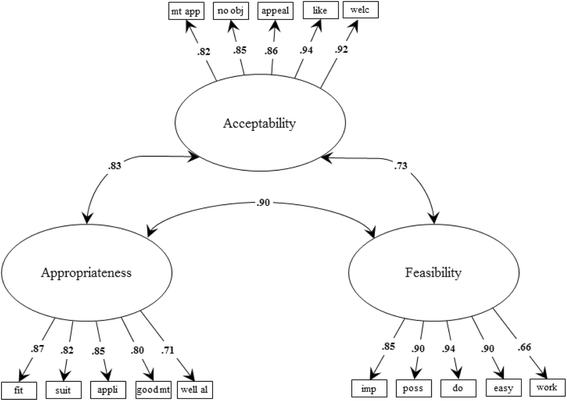Psychometric assessment of three newly developed implementation outcome measures
- PMID: 28851459
- PMCID: PMC5576104
- DOI: 10.1186/s13012-017-0635-3
Psychometric assessment of three newly developed implementation outcome measures
Abstract
Background: Implementation outcome measures are essential for monitoring and evaluating the success of implementation efforts. Yet, currently available measures lack conceptual clarity and have largely unknown reliability and validity. This study developed and psychometrically assessed three new measures: the Acceptability of Intervention Measure (AIM), Intervention Appropriateness Measure (IAM), and Feasibility of Intervention Measure (FIM).
Methods: Thirty-six implementation scientists and 27 mental health professionals assigned 31 items to the constructs and rated their confidence in their assignments. The Wilcoxon one-sample signed rank test was used to assess substantive and discriminant content validity. Exploratory and confirmatory factor analysis (EFA and CFA) and Cronbach alphas were used to assess the validity of the conceptual model. Three hundred twenty-six mental health counselors read one of six randomly assigned vignettes depicting a therapist contemplating adopting an evidence-based practice (EBP). Participants used 15 items to rate the therapist's perceptions of the acceptability, appropriateness, and feasibility of adopting the EBP. CFA and Cronbach alphas were used to refine the scales, assess structural validity, and assess reliability. Analysis of variance (ANOVA) was used to assess known-groups validity. Finally, half of the counselors were randomly assigned to receive the same vignette and the other half the opposite vignette; and all were asked to re-rate acceptability, appropriateness, and feasibility. Pearson correlation coefficients were used to assess test-retest reliability and linear regression to assess sensitivity to change.
Results: All but five items exhibited substantive and discriminant content validity. A trimmed CFA with five items per construct exhibited acceptable model fit (CFI = 0.98, RMSEA = 0.08) and high factor loadings (0.79 to 0.94). The alphas for 5-item scales were between 0.87 and 0.89. Scale refinement based on measure-specific CFAs and Cronbach alphas using vignette data produced 4-item scales (α's from 0.85 to 0.91). A three-factor CFA exhibited acceptable fit (CFI = 0.96, RMSEA = 0.08) and high factor loadings (0.75 to 0.89), indicating structural validity. ANOVA showed significant main effects, indicating known-groups validity. Test-retest reliability coefficients ranged from 0.73 to 0.88. Regression analysis indicated each measure was sensitive to change in both directions.
Conclusions: The AIM, IAM, and FIM demonstrate promising psychometric properties. Predictive validity assessment is planned.
Keywords: Acceptability; Acceptability of Intervention Measure (AIM); Appropriateness; Feasibility; Feasibility of Intervention Measure (FIM); Implementation outcomes; Implementation research; Intervention Appropriateness Measure (IAM); Known-groups; Measure; Structural validity; Test-retest.
Conflict of interest statement
Ethics approval and consent to participate
The Institutional Review Board of the University of North Carolina at Chapel Hill reviewed this study and deemed it not human subjects research (IRB #16-0237).
Consent for publication
Not applicable.
Competing interests
The authors declare that they have no competing interests.
Publisher’s Note
Springer Nature remains neutral with regard to jurisdictional claims in published maps and institutional affiliations.
Figures


References
MeSH terms
Grants and funding
LinkOut - more resources
Full Text Sources
Other Literature Sources
Medical
Miscellaneous

